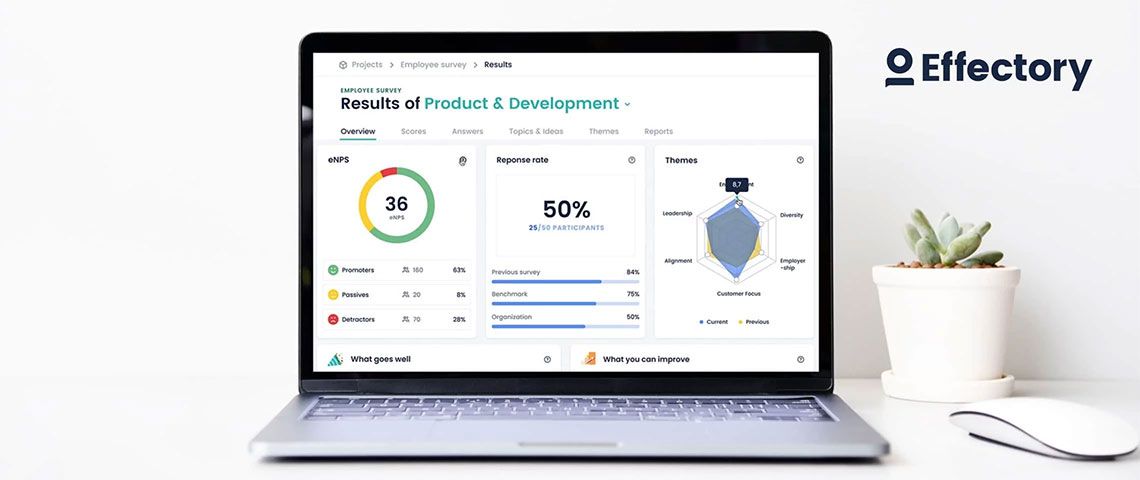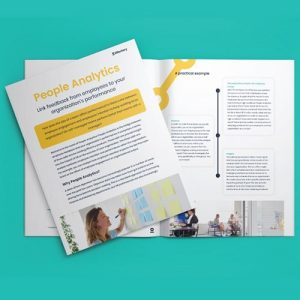What is People Analytics? And how your organization can harness the power of hard evidence to make fact-based decisions and boost performance?
What is People Analytics?

In today’s competitive business environment, organizations are consistently striving to maximize the power of their workforces. One field rapidly rising in popularity is people analytics, which involves gathering, analyzing, and leveraging data from a human perspective.
As Europe’s premier employee engagement expert, Effectory knows that by using a data-based approach, HR departments can make informed strategic choices in order to hire the best people, improve retention, increase performance, help employees thrive, and produce measurable outcomes.
This article will explore the definition of people analytics, outline its benefits, examine its efficacy, and outline how to implement a people analytics strategy within your organization.
What is People Analytics?
Simply put, people analytics applies an evidence-based approach to decision-making about how to manage employees. Data is leveraged to establish actionable information about HR strategies in order to get the ideal return on investment in every person in your company. While it might also be referred to as HR analytics or workforce analytics, people analytics is a more all-encompassing term with a broader scope. According to An Evidence-Based Review of HR Analytics, “HR analytics consists of a number of processes, enabled by technology, that use descriptive, visual and statistical methods to interpret people data and HR processes. These analytical processes are related to key ideas such as human capital, HR systems and processes, organizational performance, and also consider external benchmarking data.”
Base your HR strategy on 2021’s employee engagement statistics
Create impact with People Analytics
Link feedback from employees to your organization’s performance
DownloadPeople Analytics in Practice Today
While people analytics has been around for decades, many organizations and HR professionals have yet to take advantage of this data-driven approach. There was early skepticism about the practice due to fears that using people analytics would reduce employees to a set of numbers and cause management to stop seeing them as people. One study found that nearly half (46%) of HR professionals surveyed reported not having access to any people analytics data for their organization.
Another study found that just 7% of large companies would describe their organizations as having “strong HR data analytics capabilities”. When it comes to finances, you’d be hard-pressed to find an organization that doesn’t keep scrupulous records. Yet, when it comes to human capital, many companies are missing a major opportunity by not implementing a people analytics strategy.
The 2021 Global Employee Engagement Index™
Luckily, the industry is changing, and business leaders are beginning to recognize the value of people analytics. According to Deloitte, “The focus on big data will challenge HR leaders to build a people analytics team, bring together multi-disciplinary skills, and develop a long-range plan to ‘datafy’ HR.” With advances in technology and software, people analytics is easier to perform than ever, and much of the data needed is already available to HR departments from within their organizations. As of today, more than 70% of companies are making investments in their people analytics departments.
Facilitate increased engagement with employee training activities
Effectory’s reporting software provides HR managers and team leaders with easy-to-navigate insights drawn directly from employee surveys. Over the past 25 years, we’ve developed an efficient and effective way not only to gather relevant data but also to ensure that our customers can analyze and act upon it, too. You can always ask us to provide a demo of our dashboard.
The Benefits of People Analytics
People analytics has a proven record of success. DDI, a leadership consulting firm, reports that “organizations who excel at people analytics are 3.1 times more likely to outperform their peers.” Your organization gets a data-driven approach for measuring human capital, performance, productivity, diversity, employee engagement, and satisfaction. People analytics allows you to make decisions about how to effect positive change.
The 4 drivers of employee engagement in 2021
People analytics is valuable at every stage of the employment process, starting with recruitment and hiring. By using a data-driven approach to evaluate candidates, HR can measure prior qualifications while avoiding unconscious biases that may be present in more traditional hiring methods. In fact, the Harvard Business Review reported that using an algorithm in the recruiting process led to a 50% improvement in recruiters’ ability to find the best candidates.
People analytics is an excellent tool for tracking how employee benefits are used. Benefits are a major expense for many companies, but by using people analytics, you can establish which benefits employees find useful and which ones not being used could be eliminated to reduce costs.
Dave Ulrich reveals how to be ready for the future of work
People analytics can also be used to measure training program efficacy. Andrea Vrbanac of Axonify Inc says that while it has traditionally been difficult to track learning and development successes, “Today, it’s finally possible with the right technology, like machine learning, to gather the depth and dimension of data to tie the impact of learning to business results.”
Measuring employee engagement: the parameters to consider
Many organizations seek to track and measure employee productivity using people analytics. With comprehensive data, productivity can be tracked over time, which means you can boost productivity rates by identifying problem areas and establishing solutions.
In short, people analytics can:
- Increase productivity
- Help you hire the best talent
- Enhance employee engagement and satisfaction
- Improve employee retention
- Lower attrition rates
- Ensure a diverse workforce
- Prevent compensation disparity
People Analytics and Diversity
In today’s social climate, it has become more important than ever to ensure and foster a diverse workforce. While many organizations may believe their employee base features diversity across race and gender, people analytics can expose the reality to encourage further change.
What is Employee Engagement? The Ultimate Effectory Guide to Engagement
For example, a UK wildlife charity, RSPB, found that additional action was needed after performing a people analytics study. The study examined “whether different demographic groups experienced variations in pay, access to training, redundancy rates and disciplinaries and grievances,” and it resulted in the addition of unconscious bias training.
The organization’s Equality, Diversity, and Inclusion Manager, Catriona Corfield, said that people analytics “helped make the case to strengthen our investment in equality,” adding, “You might think your organization will magically buck the trend, but without efforts to embed diversity and inclusion into your culture, you won’t see your analytics shift.”
Similarly, people analytics can be used to ensure fair pay among demographics. By tracking employee compensation, HR departments are able to ensure equity from an unbiased perspective when it comes to raises, promotions, and salaries.
How HR can lead business success
HR and employee listening are crucial to business success. Here is how employee insights can help your organization.
DownloadTypes of People Analytics
According to CIPD, the UK’s professional body for HR and people development, there are five primary types of people analytics: operational, descriptive, diagnostic, predictive, and prescriptive.
- Operational analytics is the most basic form of people analytics. They consist simply of raw data about an organization’s employees.
- Descriptive analytics goes into slightly more detail and are able to provide broader information on a workforce’s makeup.
- Diagnostic analytics addresses a specific issue and sets out to find the root cause of the problem as well as potential solutions.
- Predictive analytics projects future data in order to anticipate progress or regression within the organization.
- Prescriptive analytics provides recommendations on how the organization can make effective changes that address the issues found during analytics studies.
While all five of these types of analytics are valuable, many HR departments only feel capable of processing the most basic types of data and are missing out on the potential benefits of more detailed analyses.
How to Implement People Analytics
The first step to harnessing the power of people analytics within your organization is to ensure your HR professionals are well-versed and trained on the topic. Regardless of the size of your organization, implementing a people analytics strategy can be beneficial. Effectory has learned this first hand working with some of Europe’s most recognizable brands.
Is your organization suffering because you don’t know enough about your workforce? Effectory is the perfect partner for planning, implementing and acting on an employee listening strategy that will result in awesome people analytics. Get in touch with one of our consultants.
While the exact process of each individual people analytics study varies depending on a number of factors, some shared elements are universal:
- Establish a goal: Beginning to harness people analytics within your organization can be overwhelming, so the first step is establishing a simple goal to work toward. This goal may be related to productivity, employee engagement, retention, or profit maximization. Then, establish a hypothesis for how this goal could be achieved.
- Create a data collection strategy: Establish the type of data you’ll need to collect to test your hypothesis and meet your goal. Consider what kind of software you’ll need and whether you will need to hire a third-party company.
- Collect the data and analyze the results: Once you have access to the necessary data, you can begin to interpret the results and plan for new HR strategy implementation to achieve your goal.
Whether you’re a leadership member or HR professional, consider implementing a people analytics strategy in your organization. Use hard evidence to identify problems within your workforce and make data-based decisions on how to rectify them and move forward. The result will be a more engaged, satisfied, and productive workforce; a more positive workplace environment; and greater organizational effectiveness.
Book a free demo. See our solutions in action.
Effectory is Europe’s Leading provider of Employee Listening Solutions. Schedule a product demo and discover how to enhance your employees’ engagement.
Demo request

